
© Ulli Weiss. (Click image for larger version)
Tanztheater Wuppertal Pina Bausch
World Cities 2012: Água (Sao Paolo)
London, Barbican
28 June 2012
www.pina-bausch.de
World Cities 2012 details
DanceTabs reviews of World Cities 2012 performances
Pina Bausch so associated Brazil with dancing that Água’s setting is constantly in motion: projected palm leaves lashed by a tempest give way to a samba band, surging greenery and cascading water. Nature always features in Pina’s pieces, even when they’re ostensibly inspired by cities. Sometimes Água’s moving images are dizzyingly beautiful, undulating palm fronds echoing the women’s waving tresses; sometimes they seem reminders that civilisation is only skin deep; or that the untamed jungle is indifferent to human concerns.
Cocktails take place on and around an array of white sofas, the party-goers elegantly dressed. Behind them, though, lurk sharp-pointed leaves – or projections of a jaguar, gambolling apes, flamingoes, tribal children swimming in river water. These National Geographic images have little or nothing to do with Sao Paolo, a sprawling, polluted metropolis. Instead, Bausch, her company and her designer, Peter Pabst, were channelling visions of a tropical paradise, where the sun always shines, the beaches are golden and people and animals frolic to lilting music – so very different from industrial Wuppertal. The spirit of Água is summed up by the lyrics of one of the songs: ‘She’s living in a dream world. Let her dream if it makes things fun, let her dream if it don’t encumber anyone’.
Nothing nasty happens in the Água idyll. The women wear gorgeous ballgowns, their skirts flaring around them like flowers in full bloom. When uninhibited Regina Advento throws herself to the ground, flinging her skirt over her head and exposing her brown legs and white pants, nobody reproves her. She’s not encumbering anyone. She even gets to wear a dress festooned with light bulbs that flash on and off in the darkness – a child’s fantasy of a fairy queen.
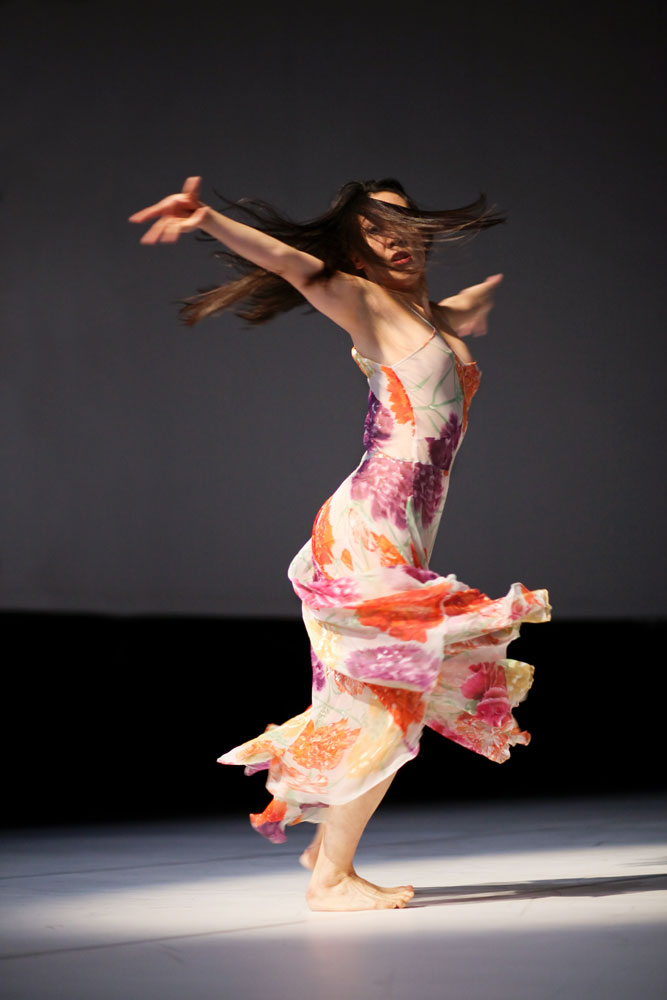
© Oliver Look. (Click image for larger version)
Advento is given the first female solo in slinky golden satin, glowing in a spotlight. (The two very busy follow-spot operators, along with the lighting technicians and lighting designer, Fernando Jacon, are duly credited in the cast list.) She is voluptuous, possessed, a Brazilian/African Candomblé priestess. Cristiana Morganti (Italian) follows in sultry red satin, wild and abandoned. Then Australian Julie Shanahan comes on self-deprecatingly, regretting that she doesn’t merit a place in the spotlight.
She explains that her dream solo performance would involve multiple props, a bonfire, water to put it out, a messy stage and glamorous clothes: in other words, a Bausch extravaganza in miniature. ‘It’s not possible’, she keeps saying. ‘Sorry’. Not much later she returns in a clinging green dress to dance a lovely solo, sensual, seductive and sad. That contrast between mockery and self-expression would be sufficient, but she and Morganti are required to serve as antidotes to the blissed-out experiences of other dancers. Shanahan reverts to being neurotic or drunk; Morganti furiously rejects the praises of a besotted suitor. They’re old-timers reprising Bausch’s view of women hiding their insecurity beneath a veneer of brashness.
Younger members of the company are allowed to be themselves without preconceptions. Thusnelda Mercy and Pablo Aran Gimeno perform their solos in white outfits and a clear white light against a plain cyclorama. Thusnelda, daughter of co-director Dominque Mercy and former dancer Malou Airaudo, has grown up within Bausch’s company. Her intense, inward-looking solo makes her seem a vulnerable Chosen One, finding and accepting her place in this theatrical society. Gimeno’s long, inventive solo to jazz music ends with his seeming inexplicably abashed as he retreats off stage. They’ve both been deprived of the choreographer who would have steered them into future roles in her creations.
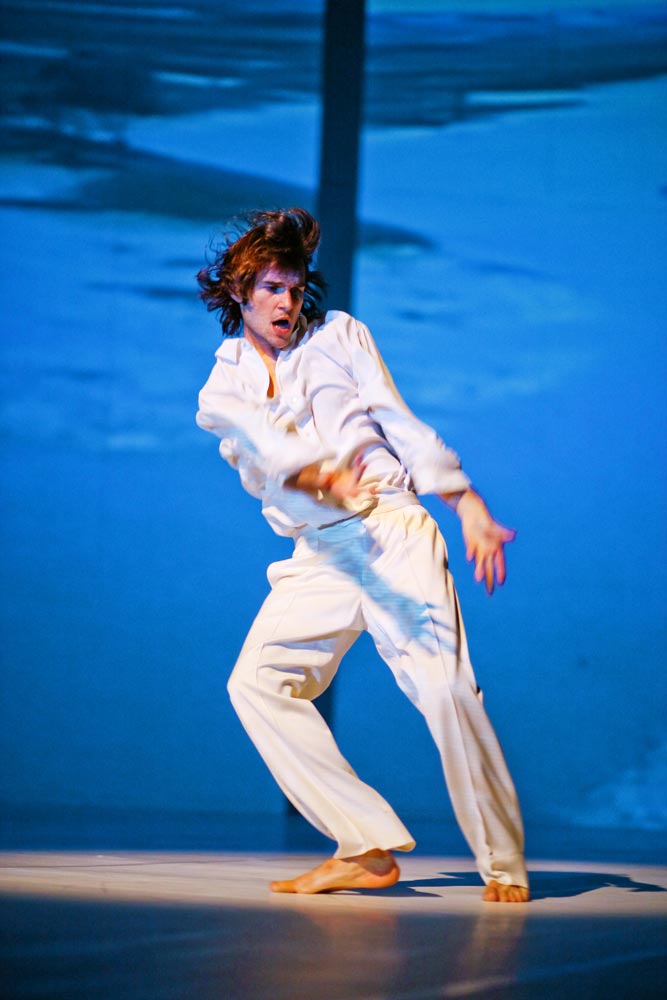
© Oliver Look. (Click image for larger version)
Men in the company are harder to identify than the women because they usually wear similar dark suits – except for four chaps in skimpy outfits and absurd high-heeled shoes who interact with the front row of the stalls, shaking hands or offering refreshments. Mostly the men indulge in slightly bizarre courtship rituals: massaging the women’s necks and shoulders, upending them, giving one a sponge bath, kissing a cleavage, eyelashes brushing an arm. There’s a comical beach scene with rude towels depicting an assortment of bodies; a sophisticated cocktail party; and sexy social dancing to the bossa nova.
The second half palls with repetition (espcially if you’ve seen Ditta Miranda Jasjfi do her crazychild/mad-witch solo in other Pina pieces or become accustomed to her being treated like a pet simply because she’s tiny). Water-play takes over for a protracted finale, set against footage of the gigantic Iaguasso Falls on the cyclorama. Gimeno paddles a palm-leaf canoe, plastic bottles are sipped and water spouted until everyone is soaked. Joyous though they are, like Yanomami children splashing in the Amazon, there is a possibility, now that Bausch is gone, that her dancers might also be an endangered tribe.












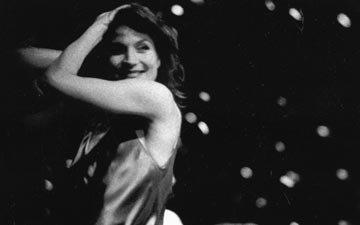
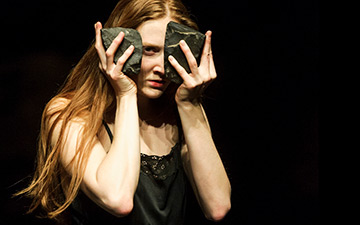
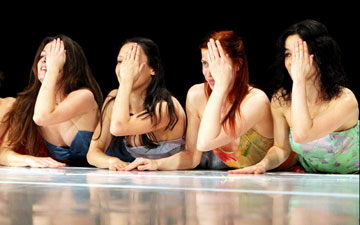

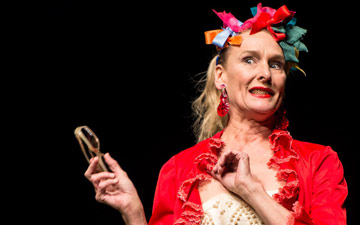
You must be logged in to post a comment.